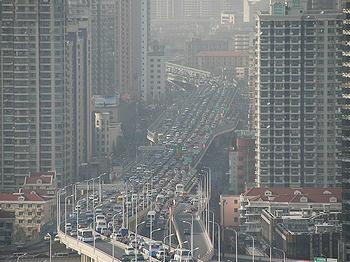
LIMA, Peru, December 9, 2014 (ENS) – The first global standard to measure greenhouse gas emissions from cities was launched Monday in tandem with the ongoing UN climate summit in Lima.
The Global Protocol for Community-Scale Greenhouse Gas Emissions Inventories (GPC) is the first internationally accepted standard for measuring emissions at the city level, enabling cities to establish credible emissions accounting and reporting practices.

Using the GPC, cities can develop an emissions baseline, set mitigation goals, create more targeted climate action plans and track their progress over time.
The GPC was developed over the past three years by the Washington, DC-based think-tank World Resources Institute (WRI), the C40 Cities Climate Leadership Group, and ICLEI – Local Governments for Sustainability.
“When it comes to the battle against climate change, cities are at the frontlines,” said WRI’s Ryan Schleeter and Wee Kean Fong, who led development of the Global Protocol.
Cities are the largest source of the problem, they told the biggest gathering of mayors and climate action experts since the UN Secretary-General’s Climate Summit in September in New York, because half the global population lives in urban areas, and cities produce 70 percent of the world’s energy-related CO2 emissions.
Even now, emerging cities are catching up to developed cities in their emissions, said Fong and Schleeter. “The Chinese cities of Beijing, Shanghai, and Tianjin, for example, have per capita emissions similar to those of large European and North American cities. And the environmental impact of urban areas is poised to grow – cities are expected to gain 1.4 billion people in the next 20 years and attract trillions of dollars’ worth of investments.”

At their meeting Monday in Lima’s historic municipal hall, the mayors of the world’s major cities, and many smaller cities as well, cemented the commitment of local governments to step up collaborative climate action and scale down greenhouse gas emissions.
They produced the Lima Communiqué, which will feed into the ongoing negotiations across town at COP20, the 20th Conference of the governments that are Parties to the UN Framework Convention on Climate Change.
There, delegates from more than 190 countries are negotiating the draft text of a new universal legally-binding climate change agreement to limit greenhouse gas emissions, to be adopted a year from now in Paris.
ICLEI President David Cadman of Vancouver, Canada, said, “The COP20 is paramount to producing a decisive agreement in Paris 2015, which will determine the post-2015 climate agenda. To achieve this goal, we need to enable more ambitious actions and commitments from local and subnational governments to help nations move to a climate-friendly track.”
Rio de Janeiro, Brazil is one of the 35 cities that pilot-tested a beta version of the Global Protocol in Australia, China, Europe, India, South Africa, South America and the United States.
In 2011, Rio de Janeiro Mayor Eduardo Paes enacted an ambitious climate change law, setting a goal to avoid 20 percent of its emissions by 2020. But at the time, Rio officials had no idea how much the city was emitting, or where its emissions were coming from.
By using the new GPC protocol, city officials calculated that transport produced 39 percent of its emissions and waste produced 19 percent. They found that targeting emissions reductions in these sectors would help Rio meet its 20 percent target.
The number of cities using the GPC has since risen to more than 100 and is expected to grow in the near future.
Lima Mayor Susana Villarán said, “Cities are made up of its citizens, and if the changes are not coming from new generations, from the community, we are walking through unknown paths into our planet’s uncertainty. We cannot allow that.”

“By 2035,” Mayor Villarán told her counterparts at Monday’s meeting, “75 of 100 people are going to live in urban areas. As mayors, we have the responsibility of ensuring that our cities would be livable for future generations.”
“The legacy of this COP20 in Lima should be for a greater, more robust engagement of local governments beginning with us, starting today in Lima, towards Paris and beyond,” she said.
Under the Compact of Mayors, the world’s largest effort for cities to fight climate change, debuted at the UN Secretary-General’s Climate Summit in September, cities will set climate targets and report against these targets into a reporting platform, using the newly-launched GPC.
All reported data will be consolidated and made publicly available through the Carbon Climate Registry, the Compact’s designated central repository.
New research shows that existing city commitments alone could reduce annual carbon emissions by 454 megatons of CO2 equivalent in 2020.
“Cities are economic and population hubs, making them critical actors in the fight against climate change,” said Johannesburg Executive Mayor Mpho Parks Tau, a member of C40’s Steering Committee.
“The C40 network alone represents more than 500 million people around the world. Together with our partners, our collective efforts to encourage cities to sign onto the compact will help them to set more ambitious climate targets and take action the ground. That is the power of cities,” said Tau.
Cadman said, “We are grateful for the vision and great leadership of the City of Lima and for giving local governments a proper venue where they can jointly set targets, spur new partnerships, and inspire ambition among cities and nations alike.”
Copyright Environment News Service (ENS) 2014. All rights reserved.
